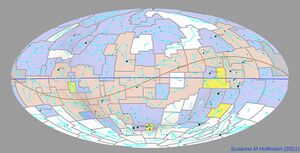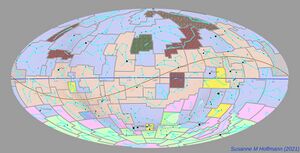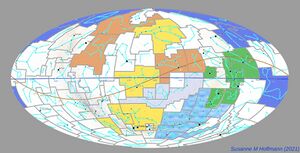IAU-Constellations Origins: Difference between revisions
(Created page with "In the past decades, a viewgraph of a former Harvard director on "constellation families" has become rather popular, although it's wrong. === Origins of constellations === light brownish: Babylonian constellations blue: Greek constellation light green: constellations created by Dutch sailors (depiction on globe by Plancius 1598, in Bayer’s Uranometria 1603, and in the star catalogue published by de Houtman in 1603) dark green: english asterism, created in the...") |
No edit summary |
||
| Line 1: | Line 1: | ||
In the past decades, a viewgraph of a former Harvard director on "constellation families" has become rather popular, although it's wrong. |
In the past decades, a viewgraph of a former Harvard director on "constellation families" has become rather popular, although it's wrong. |
||
| ⚫ | |||
[[File:Kosmologs Karten herkunft alt-1024x521.jpg|alt=Stellarium map, handcoloured|thumb|Ancient constellations coloured according to their origin (CC BY Susanne M Hoffmann 2021)]] |
|||
| ⚫ | |||
| ⚫ | Remark: Pisces, the two fish are coloured blue-and-brownish (striped) because the constellation has Babylonian roots but underwent several transformations. The original Babylonian constellation at this area was named “The Tails of the Giant Swallow” and later trandformed into the Uruk constellation of the “Swallow-Fish” and the Greco-Egyptian “two Fish” because for the Egyptians the Autumn Square (that was called “One Field” by the Babylonians) was a squared water tank for for the Egyptians. Thus, the modern constellation of Pisces is a product of transformations. |
||
[[File:Kosmologs Karten herkunft-1024x521.jpg|alt=Stellarium map, handcoloured|thumb|All constellations coloured according to their origin (CC BY Susanne M Hoffmann 2021)]] |
|||
=== Origins of constellations === |
=== Origins of constellations === |
||
| Line 23: | Line 32: | ||
Scutum, the shield was invented by Hevelius, Monoceros, the unicorn and Columba, the dove were (probably) invented by Plancius (for the unicorn this is uncertain); the Cross had already served as a navigational asterism for long time (introduced by A. Corsali, the navigator of A. Vespucci after a Christian asterism mentioned in their compatriot Dante’s poem) while the stars originally belonged to the constellation of the centaur. |
Scutum, the shield was invented by Hevelius, Monoceros, the unicorn and Columba, the dove were (probably) invented by Plancius (for the unicorn this is uncertain); the Cross had already served as a navigational asterism for long time (introduced by A. Corsali, the navigator of A. Vespucci after a Christian asterism mentioned in their compatriot Dante’s poem) while the stars originally belonged to the constellation of the centaur. |
||
| ⚫ | |||
| ⚫ | |||
| ⚫ | Remark: Pisces, the two fish are coloured blue-and-brownish (striped) because the constellation has Babylonian roots but underwent several transformations. The original Babylonian constellation at this area was named “The Tails of the Giant Swallow” and later trandformed into the Uruk constellation of the “Swallow-Fish” and the Greco-Egyptian “two Fish” because for the Egyptians the Autumn Square (that was called “One Field” by the Babylonians) was a squared water tank for for the Egyptians. Thus, the modern constellation of Pisces is a product of transformations. |
||
=== Mythological groups === |
=== Mythological groups === |
||
[[File:Kosmologs Karten grpMyth-1024x521.jpg|alt=Stellarium map, handcoloured|thumb|Constellations coloured according to their Greek mythology (CC BY Susanne M Hoffmann 2021)]] |
|||
Revision as of 16:52, 27 August 2024
In the past decades, a viewgraph of a former Harvard director on "constellation families" has become rather popular, although it's wrong.
Map of ancient Greco-Babylonian constellations
Blue are the so-called Greek constellations (a multi-cultural mix already), brownish the Babylonian ones and yellow the (later) Christian ones.
Remark: Pisces, the two fish are coloured blue-and-brownish (striped) because the constellation has Babylonian roots but underwent several transformations. The original Babylonian constellation at this area was named “The Tails of the Giant Swallow” and later trandformed into the Uruk constellation of the “Swallow-Fish” and the Greco-Egyptian “two Fish” because for the Egyptians the Autumn Square (that was called “One Field” by the Babylonians) was a squared water tank for for the Egyptians. Thus, the modern constellation of Pisces is a product of transformations.
Origins of constellations
light brownish: Babylonian constellations
blue: Greek constellation
light green: constellations created by Dutch sailors
(depiction on globe by Plancius 1598, in Bayer’s Uranometria 1603, and in the star catalogue published by de Houtman in 1603)
dark green:
english asterism, created in the 1670s – included in a newly invented constellation by Hevelius (1687)
dark red: Hevelius (Polish), 1687
pink: Lacaille (French), 1756
with the pattern of a leopard: Giraffe, probably invented by Plancius, too – first appearance on his 1612 globe but roots unknown
yellow: Christian.
Scutum, the shield was invented by Hevelius, Monoceros, the unicorn and Columba, the dove were (probably) invented by Plancius (for the unicorn this is uncertain); the Cross had already served as a navigational asterism for long time (introduced by A. Corsali, the navigator of A. Vespucci after a Christian asterism mentioned in their compatriot Dante’s poem) while the stars originally belonged to the constellation of the centaur.
Mythological groups
dark blue: the figures of the legend of Andromeda and Perseus
(Andromeda and Perseus themselves, the sea monster called Ketos and Andromeda’s parents)
orange: myth of Hercules,
(according to Greek mythology, the hero had defeated the monster lion of Nemea, the Draco-Snake (the snake who guarded the apples of the Hesperids), and crunched a crab while fighting with a dragon.
green: the heavenly hunting scene (Orion-group)
the hunter Orion is accompanied by two hunting dogs, he fights with the bull but his (big) dog hunts a hare
light blue/ water constellations:
The giant ship (Puppis, Carina, Vela) that the Dutch had enlarged with regard to the ancient ship, is accompanied by a Flying Fish (Volans) which possibly landed on deck of the historical ship while fleeing from the huge predator Dorado.
light gray: Hydra-group
As we are defining groups with common mythological background, we could also connect Hydra with the Bowl (Crater) and the Raven (Corvus). According to Greek mythology, the raven carried the water snake to god Apollo which is not really convincing with regard to their sizes in the sky. However, it is known that both constellations were copied as a group from ancient Babylon to Greek astrometry.
golden yellow:
the “holy” Greek constellations: the altar (Ara) with its fire is the place were the gods represented by the natural force of fire witness oaths. The centaur represents the wild man who becomes civilised by sacrificing an animal at the altar. Virgo and Ursa Major symbolizse the ancient Greek rituals of initiation for men and women respectively.
References
Zotti, G., Hoffmann, S. M., Wolf, A., Chéreau, F., & Chéreau, G. (2020). The Simulated Sky: Stellarium for Cultural Astronomy Research. Journal of Skyscape Archaeology, 6(2), 221–258. https://doi.org/10.1558/jsa.17822
Hoffmann, S. M. (2021). Wie der Löwe an den Himmel kam – Auf den Spuren der Sternbilder. Franckh Kosmos Verlag







